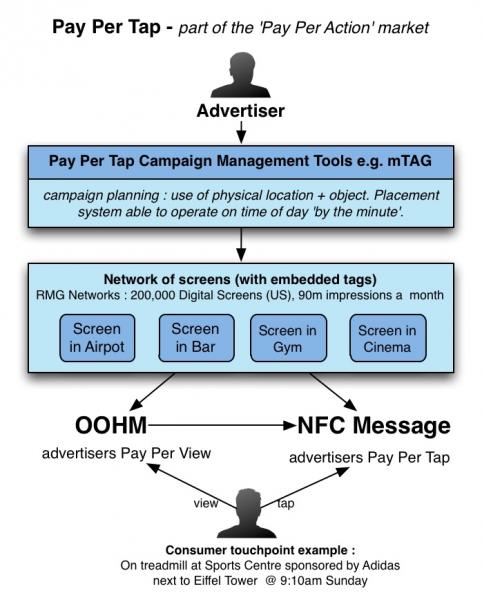NFC Points To The “Pay-Per-Action” Market
My recent paper looked at the "tap" paradigm exhibited by technologies such as NFC. I want to explore the implications of how the innocuous "tap" points the way to a not just a richer mode of marketing interaction but hints at how the "pay per" market might develop due to offline/online convergence.
There are primarily two models to the placement of NFC campaigns — the first is on your own property, which may be anything like a store, product, poster, or packaging. The second is on the outdoor network of enabled bus stops, cinemas, smart posters, and public screens. Many large shopping centers and 0ut-of-home (OOH) media stations are already enabled with NFC tags and their real-estate can be addressed dynamically by marketers to put apps, links, and media on them.
Examining the campaign management systems for tag-based approaches shows their toolset to be very similar to pay-per-view (PPV) , pay-per-click (PPC), and display tools. The difference with pay-per-tap is that the location the marketing message is delivered into is a tag rather than a a slot in Google Search results or a display location.
The figure below shows a recent campaign undertaken by Blue Bite and RMG Networks. Doesn’t it look just a little bit like the purely online models?

LOOKING AT OFFLINE AND ONLINE IN CONCERT REVEALS THE "PAY-PER-ACTION" MARKET
The PPC and display industries easily have the smartest profiling, placement, and measurement systems but they aren’t addressing the real world, which is slowly filling up with tags and other digital touchpoints.
- The pay-per-tap and pay-per-view/click (PPV/C) will integrate. We expect to see the large PPC and display players begin to collaborate with real-world tagging systems. Knowing for certain that a customer touched a specific object in specified location will make for assured targeting scenarios with higher conversion. The perennial question of "where shall I spend my next euro" will expand to include real-world placement.
- Context information goes up a gear. This is perhaps the most exciting aspect for Interactive Marketers as by addressing both real world and online in a joined up way – new marketing experiences can be crafted creating a deeper resonance with customers. From a context point of view offline marketing has incredibly useful information such as place and object. The promise of the real world as both a channel and a data source is imminent is here — it's just not hooked up to your search and display programs.
- Analytics will to extend to include actions undertaken in the real world. Taps will come to be added to an emerging pay-per-action analytics field. Tap will join clicks in providing a more rounded view of a campaign interaction across the virtual and the real world. A "physical" check-in or unlock will have more weight than it’s tapless counterpart. The fledgling world of attribution will have to stretch the model to include the real-world touchpoints enabled by technology like NFC.
- Technologies like NFC are a step on the path to the Internet of things. Digital touchpoints are spilling out from the web into everyday objects — not just connected TVs and gaming consoles. By giving each tag a unique identity matching it with a URL makes it an endpoint. This is one of the basic building blocks to addressing not only webpages but things.